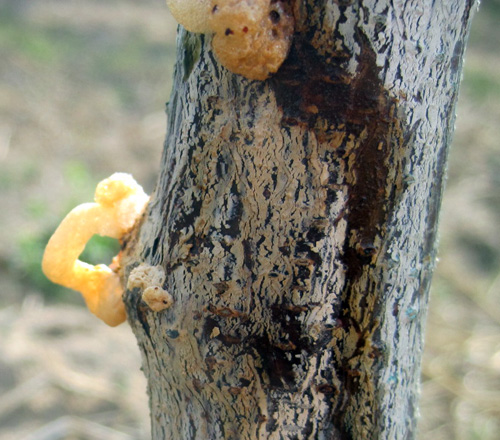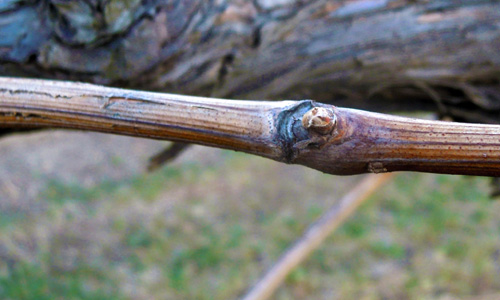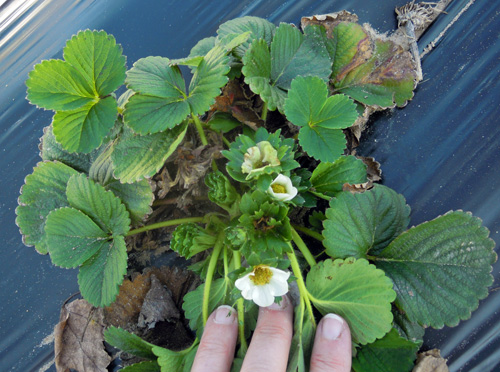Southwest Michigan fruit regional report – April 23, 2013
Plants are budding out slowly as mild warmth brings slow, spring growth.
Weather
Warmer weather last week allowed plants to develop slowly. Green tissue is visible in many areas. Last week was rainy with five days of rain and total accumulations of 2 to 5 inches. Highs were in the 50s and 60s. Lows generally were above freezing. Clear, calm conditions over the weekend led to a hard freeze on Sunday morning (April 21) with lows near 20. Damage from this freeze is reported in tart cherries and other stone fruit. We continue to lag well behind our normal development.
There is very little difference in growing degree days (GDD) across the southern region. Comparing the GDD accumulations since 2000 at the Southwest Michigan Research and Extension Center (SWMREC) shows that we have only about one-third of the heat units we normally do. We are probably two weeks behind normal development.
Normally, stone fruit bloom would be well underway and there would be a real danger of damage from temperatures just below freezing. (See the Michigan State University Extension article “Freeze damage depends on tree fruit stage of development.”) We are about half-way through the freeze season or the period in time when freezing temperatures are likely.
This week will be cooler with highs in the 50s and 60s. Lows are forecast to be around freezing with warming over the weekend. More rain events will move though the area this week. Continuing showers and cool weather will keep plant growth slow this week.
Now that green tissue is exposed, growers will need to protect against early diseases. Many areas received 2 to 3 inches of rain last week with areas along the lakeshore and to the north receiving 4 to 5 inches. Many soils are flooded or at field capacity and areas with poor drainage are saturated with standing water in the fields. Check your local weather station and conditions at Enviro-weather.
Southwest Michigan GDD Summary from January 1 to April 21, 2013
|
Station |
GDD 42 F |
GDD 45 F |
GDD 50 F |
|
Benton Harbor (SWMREC) |
132 |
88 |
41 |
|
Fennville (TNRC) |
91 |
57 |
23 |
|
Average for the region |
126 |
83 |
37 |
Tree fruit
Stone fruit buds are close to first bloom. Growers are finishing their peach pruning. Examine last year’s growth for evidence of San Jose scale infestations. Growers are applying copper to stone fruits and apples. Early season oil and insecticide sprays for San Jose scale, mites and aphids are a good option if weather permits. Oil sprays should not be applied if there is a danger of a freeze in the following two days.
Apricot buds are at red calyx. Black stem borers, a type of ambrosia beetle, have been an occasional pest on 1st and 2nd leaf apricots and plums in sandy sites in southwest Michigan. Adult beetles emerge from infested trees and seek new hosts beginning at budburst. Adults burrow pin-sized tunnels deep into and down the middle of young trees. Afflicted trees may exhibit pencil lead-size frass columns and ooze from entry holes, and die within a few months.

This photo from 2012 shows ooze from the entry hole in an apricot made
by the black stem ambrosia beetle. Photo credit: Bill Shane, MSU Extension
No trials have been done in Michigan, but presumably preventative insecticide treatment to the trunk before bloom would provide some protection against entry. (See “New bark beetle pests in Michigan.”)
Peach fruit buds are generally at red calyx, with pink bloom beginning to show on early blooming varieties such as Redskin and Loring in early sandy sites away from Lake Michigan. Leaves are emerging. Fruit bud numbers are very high this year following last year’s light crop. Copper applications can suppress bacterial spot. The copper reduces bacterial populations that will damage leaves and fruit after bloom. See “Management of bacterial spot on peaches and nectarines” for more details. Be careful to not over-apply copper. Reapplication of copper is not needed until significant amounts have been removed by rainfall.
In cherries, sweet cherry buds are at green tip and should burst late this week. If you still need to apply copper to reduce bacterial canker, the end of the early season copper spray window is when it warms up and buds break.
Tart cherry buds are at green tip in Berrien and Van Buren counties. Damage has been reported for the freeze on April 21. Montmorency cherries are much more tolerant of copper, so growers still have time to apply this material.
In plums, both Japanese and European fruit buds are at late bud swell to tight cluster. Low rate copper sprays now will help suppress bacterial spot symptoms after bloom. Black knot infections can occur from first green buds until active shoot growth slows down in early to mid-summer. The most important fungicide treatment time for this disease is from first color on flower buds until about three weeks later.
Apples range from one-fourth of an inch to early tight cluster in Berrien County. Scab ascospores were caught during rains beginning April 17. This rain was a scab infection period throughout the southwestern Michigan area. Copper applications should not be used for fresh market apples once the flower buds are exposed (e.g., tight cluster) to avoid phytotoxicity and russetting of the fruit finish. The most important period for control of powdery mildew starts at pink and continues until terminal bud set. Patrol orchards for infested terminal growth from last year’s infections and cut off these infections when seen.
Pear buds have swollen markedly over the past week. Pear scab control is needed as susceptible green tissue emerges. Pear psylla management begins at the white bud stage.
Small fruit
Growth in grapes is proceeding slowly with little movement beyond what was reported last week. More buds have cracked their scales, but many are still dormant. Grapes are ready to go when we get warmer temperatures above 50 F. There is still time to make a dormant application of lime sulfur, sulfur or copper to reduce inoculum of phomopsis, anthracnose, black rot powdery and downy mildew. (See “There is still time for dormant sprays in grapes.”) This may be beneficial to growers whose vineyards developed problems with these diseases last year under minimal fungicide application regimes. Check page 179 in the 2013 Michigan Fruit Management Guide (E-154) to determine whether or not the grape varieties you are spraying are sensitive to copper or sulfur.

Scale crack is just visible in this photo of a Concord grape bud.
Photo credit: Diane Brown, MSU Extension
As buds develop, climbing cutworms and grape flea beetles will be the insect pests to watch out for. Pre-emergence herbicides should be applied now. Check pages 260-261 of 2013 Michigan Fruit Management Guide (E-154) for recommended products.
In blueberries, flower buds of early varieties are beginning to open in Van Buren County, but there is very little green tip in the leaf buds. Green tissue is out in Berrien County. Many fields are showing a lot of dead and weak wood as a result of last year’s drought. Fields that were irrigated heavily last year show a good bud set on new wood.
As leaf tissue emerges, mummy berry infections are possible. The rainy weather forecast looks ideal for mummy berry. Growers should be scouting for mummy berry apothecia, also called mushrooms or trumpets. (See “Scouting and management of mummy berry in blueberries.”) Mummies have been found in wet sites, but most are small (about 1 mm while some are approaching 2 mm) when spore release begins.
Spores are generally released under dry conditions, not during rains. Free water is required for the spores to germinate and begin infection. See “Understanding mummy berry shoot strikes” for more information on the infection conditions necessary for mummy berry shoot strike, including temperature and wetness requirements.
Freezes increase the susceptibility of tissues to infection, so protectant materials should be applied before freezes while systemic materials should be applied quickly after a freeze. See the 2013 Michigan Fruit Management Guide (E-154) for more information on fungicide sprays for mummy berry control.
In strawberries, new leaves are emerging from the crown. The flower trusses are not visible in the ground. Strawberries in the high tunnel have visible flower trusses and open flowers.

Flower trusses and bloom in high-tunnel strawberries.
Photo credit: Diane Brown, MSU Extension
Bramble buds are moving with one-fourth to one-half of an inch of green tissue out. New primocanes are beginning to emerge from the ground. Fall bearing raspberries have been mowed. Lime sulfur treatments for anthracnose are being applied. High-tunnel raspberries are more advanced than raspberries in the field with new growth of 2 to 6 inches.
Upcoming meetings
Our next weekly Monday fruit IPM meeting is on April 29 at Fruit Acres Farms at 5 p.m. Mike Hansen, regional supervisor and state apiarist of the Michigan Department of Agriculture and Rural Development, will discuss issues related to pollination and honey bees. These weekly meetings are good for one RUP credit and will continue through the end of June.



 Print
Print Email
Email



